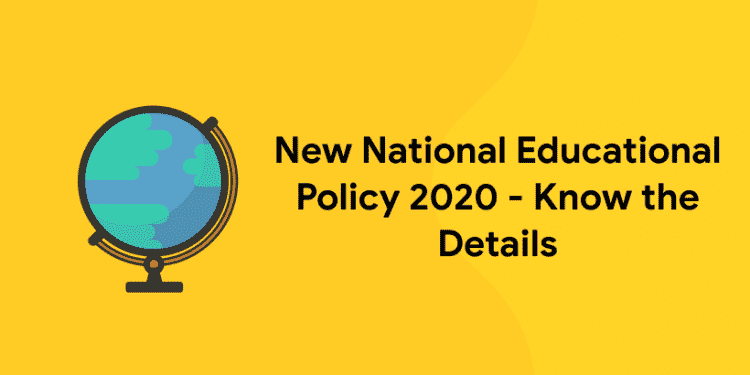Table of Contents
“Education is the passport to the future, for tomorrow belongs to those who prepare for it today”. – These are the words of the Malcom X who was an American Muslim minister, and human rights activist who was a popular figure during the civil rights movement. The existing system of education in india will be termed as the educational history of india and tomorrow education will be known as the new education policy of 2020. The existing educational system according to the 1986 educational policy has been revamped according to the recommendation of Kasthoori Rangan committee report regarding educational reforms in India that is accepted by the central government as the New Educational Policy 2020. Here Let us look into details and highlight the major aspects of New Education Policy (NEP) 2020.
Why New Educational Policy (NEP) 2020?
The previous major educational policy in India was according to the recommendation of the Kothari Commission report or the National education Commission during the period 1964- 1966. The major practices and customs of education with which we follow till now are according to the recommendations of national educational policy framed in 1986. But the scenario has been changed. There arose many sounds for the need of new educational policy from different parts of the country due to the increase of unemployment and all. The IT companies who recruit students from Indian colleges were started to give further education which makes them equipped for handling their affairs. The increased unemployment rate and increasing population forced the policy makers to think about a revamped education plan.
The New education policy has been implemented as part of the global education development agenda reflected in the Goal 4 (SDG4) of the 2030 Agenda for Sustainable Development, adopted by India in 2015 – seeks to “ensure inclusive and equitable quality education and promote lifelong learning opportunities for all” by 2030.
Download Entri for More Current Affairs
What are the Objectives or Principles Behind the New Educational Policy 2020
1: Who was the first woman President of India?
- Recognizing, identifying, and fostering the unique capabilities of each student.
- according the highest priority to achieving Foundational Literacy and Numeracy by all
- students by Grade 3
- flexibility
- no hard separations between arts and sciences, between curricular and extracurricular activities, between vocational and academic streams
- multidisciplinary and a holistic education
- emphasis on conceptual understanding
- creativity and critical thinking
- impart ethics and human & Constitutional values
- promoting multilingualism and the power of language in teaching and learning
- life skills
- focus on regular formative assessment for learning
- extensive use of technology
- respect for diversity and respect for the local context
- full equity and inclusion
- synergy in curriculum across all levels of education
- teachers and faculty as the heart of the learning process
- a ‘light but tight’ regulatory framework to ensure integrity, transparency, and resource efficiency of the educational system through audit and public disclosure while encouraging innovation and out-of-the-box ideas through autonomy, good governance, and empowerment
- outstanding research
- continuous review
- a rootedness and pride in India,
- a rootedness and pride in India,
- substantial investment in a strong, vibrant public education system as well as the encouragement and facilitation of true philanthropic private and community participation
To accommodate the above said principles and achieve the above said goals into the new educational Policy 2020 there has been structural change in the educational system itself. The change in the educational system can be broadly classified into 2 categories
- School Education
- Higher Education
Free UPSKILLING Courses!
Take your first step toward mastering in-demand skills, acing interviews, and securing top-tier jobs with Entri's free upskilling courses.
Start Learning!School Education
The entire system of school education has been changed. The existing system of school education comprising Lower Primary (LP) Upper Primary (UP) high School (HS) Higher Secondary School (HSS) has given way to the new system of 5+3+3+4 school education structure with foundational preparatory middle secondary school of education system.
Ace your Preparation for Competitive Exams!
The key changes in this system
- Mother tongue as medium of instruction till class 5 wherever possible
- New curriculum to include skills like coding and vocational integration from class 6
- Class 10 and 12 board exams to be made easier and redesigned
- A new accreditation framework and an independent authority to regulate public and private schools
- National educational technology forum and separate technology unit to enhance digital learning
The Higher Education
Higher education has also made considerable changes in the sector by the New Education Policy 2020. Higher education has also changed from different aspects. The 3-year degree course has been replaced with a 4-year degree. The policy also introduces exit points for the students who are not able to complete a four years course. They will be given a certificate based on the years they have studied. The regulatory system of higher education has also been changed into a single regulatory authority called the Higher Education Commission of India (HECI). The first vertical of HECI will be the National Higher Education Regulatory Council (NHERC). It will function as the common, single point regulator for the higher education sector including teacher education and excluding medical and legal education, thus eliminating the duplication and disjunction of regulatory efforts by the multiple regulatory agencies that exist at the current time. The second vertical of HECI will, therefore, be a ‘meta-accrediting body’, called the National Accreditation Council (NAC). Accreditation of institutions will be based primarily on basic norms, public self-disclosure, good governance, and outcomes, and it will be carried out by an independent ecosystem of accrediting institutions supervised and overseen by NAC. The third vertical of HECI will be the Higher Education Grants Council (HEGC), which will carry out funding and financing of higher education based on transparent criteria, including the IDPs prepared by the institutions and the progress made on their implementation. The fourth vertical of HECI will be the General Education Council (GEC), which will frame expected learning outcomes for higher education programmes, also referred to as ‘graduate attributes’.
Attempt Daily Current Affairs Mock Test! Download Entri App
Conclusion
The education system is there at the door step for full alteration. The only thing is there to change is ourselves. There are criticisms and appreciations for this policy. Hope that the policy will make the future generation rich of education which is not only used to build their career but also make them enrich with great humanitarian values and prosperous in life. Study the above changes in exam point of view to have a clear knowledge regarding the general knowledge for competitive exams like UPSC SSC PSC and bank exams 2020. Keep studying Keep winning.














